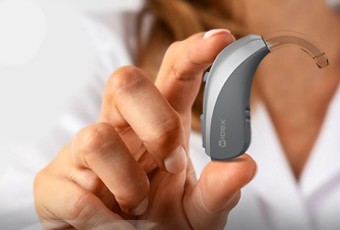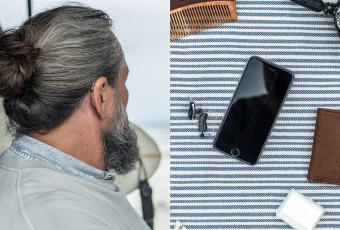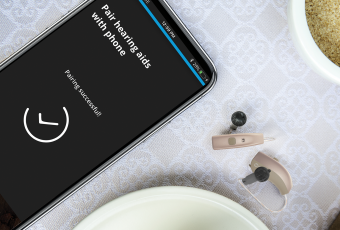For watching TV
In Europe, an adult spends on average almost 4 hours per day watching TV. In the US, it’s over 5 hours. If you love TV as much as the next person, and you’re a hearing aid wearer, you are likely to experience sound issues like distortion. Maybe you sometimes turn up the volume to improve the sound. But that’s probably not so popular with the people you’re watching TV with – and it doesn’t always solve the problem. That’s why they make assistive listening technology for TV watching. These devices help improve the sound by delivering it right into your hearing aid, making room for adjusting the volume on a personal level instead of doing it for the entire room.
Some listening devices require a neckloop, but newer TV sound-streaming solutions can connect directly with your hearing aid. This can be an advantage for the 78% of hearing aid users who find it difficult to understand speech from the TV. Most solutions come with a remote control to adjust the volume; in some cases you can do it with an app.
For talking on the landline
The phone is ringing. You pick it up, but the immediate feedback is making your hearing aid act up. If you enjoy talking on the phone and you experience problems like feedback or echo, then you’re not alone. Thankfully there are a multitude of phones for anyone with a hearing impairment, like amplified phones.
Amplified phones do what it sounds like they do: they amplify the sounds, so you can turn up the volume as much as you need. They also make it easier to hear high-pitch sounds, which can be a challenge.
Other phones that are compatible with hearing aids can be acoustic or telecoil. The acoustic phone is a good choice if you have a mild hearing loss, because it allows you to hear background sounds as well. For someone with a severe hearing loss, sounds in the background make it very hard to hear, so in that case a telecoil phone is the better choice. This phone connects directly to your hearing aid, so the voice at the other end becomes predominant and doesn’t drown in all the sounds around you.
If you only use a smartphone and don’t own a landline, there are options for that too.
For connecting to devices like smartphones or tablets
We are more connected than ever. 36% of the world population are smartphone-users and around 20% own a tablet. It’s great, because these devices help us stay in touch with people and events around us. They’re also great for watching shows or listening to music or podcasts – wherever and whenever.

Some newer hearing aids will allow you to connect these devices to your hearing aids directly, so the sounds from the devices don’t compete with the sound from your surroundings. If you don’t own one of these hearing aids, you can get other hands-free solutions that help deliver the sound from wireless units to your hearing aids.
The small listening devices usually come as a neck-loop that you put around your neck. They pick up the signal from the device you’re streaming sound from and deliver it straight to your hearing aid without noisy disturbances. They work through Bluetooth. For making calls, you can even get clip-on microphones so that you can talk on your smartphone without having to reach for it. If you’re not on the phone but having a conversation in real life, you can put the microphone on your conversation partner.
For listening at events or in public
Having a hearing loss, you may find it difficult to follow the action – or at least the sound – when you go to see a play, a movie or a lecture. The sound you want to hear is very easily compromised by all the other sounds around you that your hearing aid picks up too.
That’s when you can use a listening device that picks up the sound via telecoil and transfers it straight to your hearing aids. Today, lots of churches, theaters and other public venues make sure that the sound can be received by listening devices to help you follow what’s being said if you’re wearing a hearing aid.
For learning something at school
Kindergartens and schools are notoriously noisy. Even when the break is over, and the lesson begins in the classroom, there’s background noise, voices and other sounds that can interfere with how well you hear the teacher – or your classmates, for that matter.
Different manufacturers offer assistive listening systems that help hearing aid users in a classroom setting. Usually solutions consist of a microphone for the teacher and an FM receiver in the child’s hearing aid.
Talk to one of our Hearing Care Providers about accessories for your current Widex Hearing Aids.
Talk to one of our Hearing Care Providers about accessories for your current Widex Hearing Aids.














